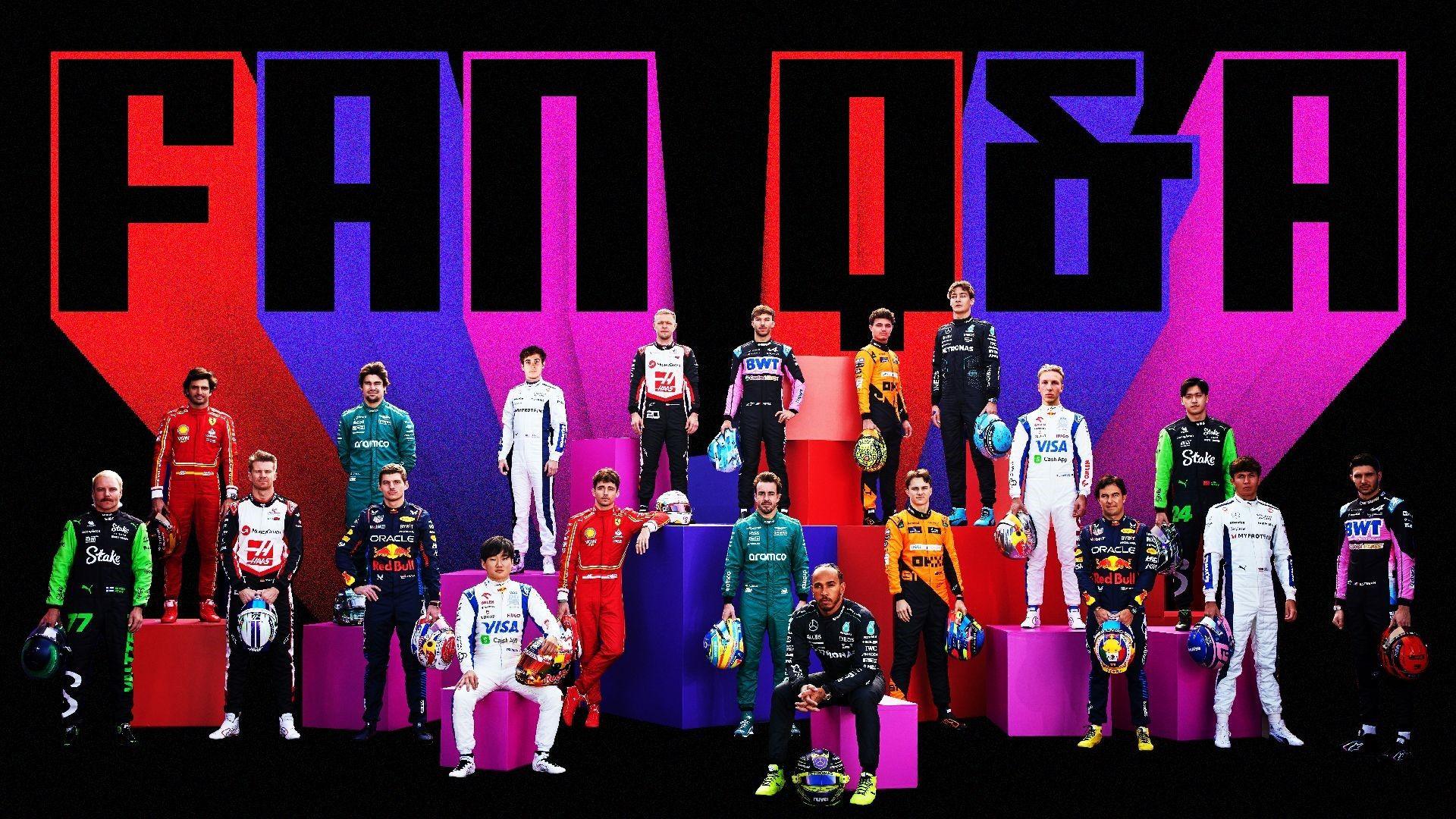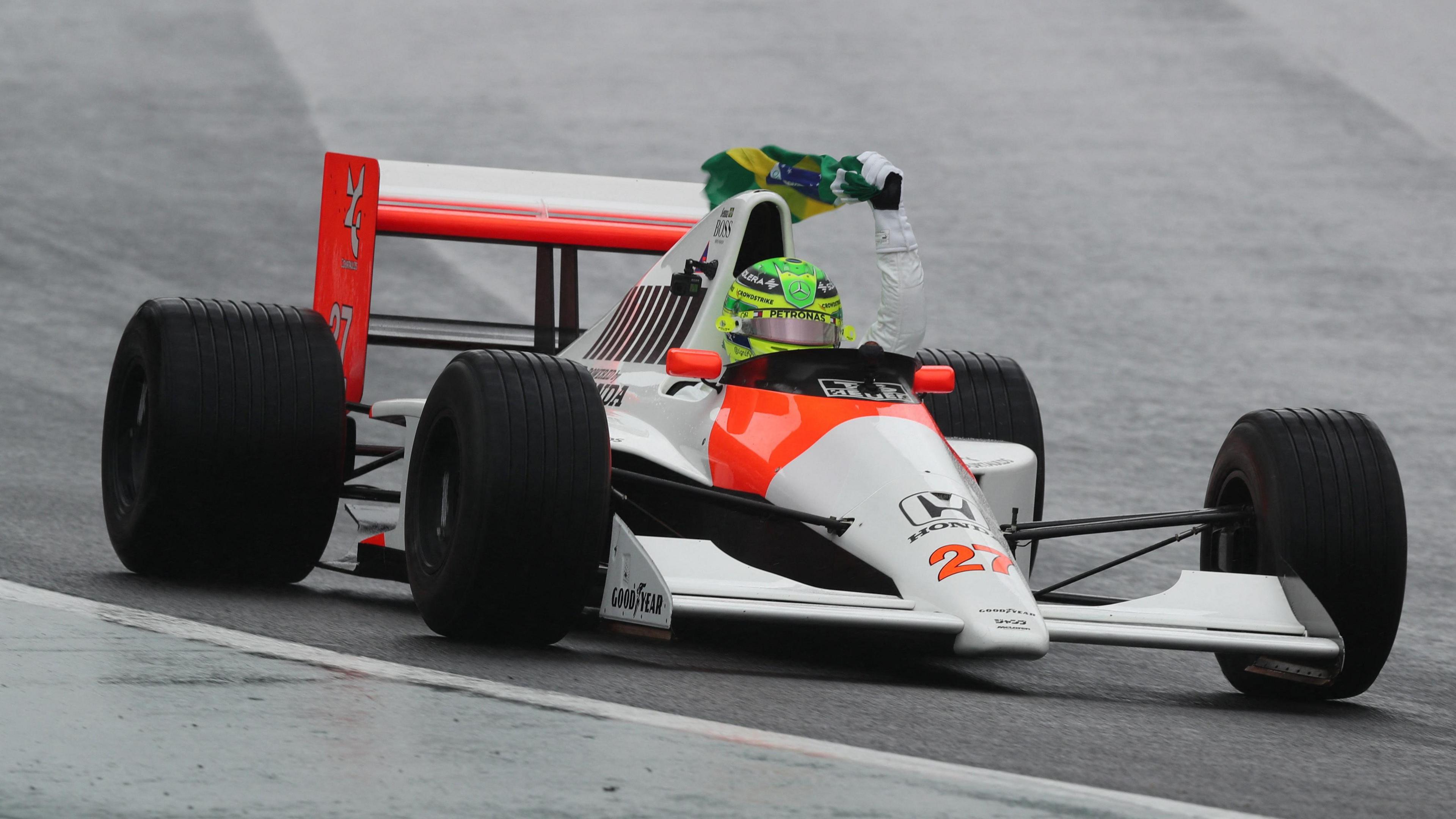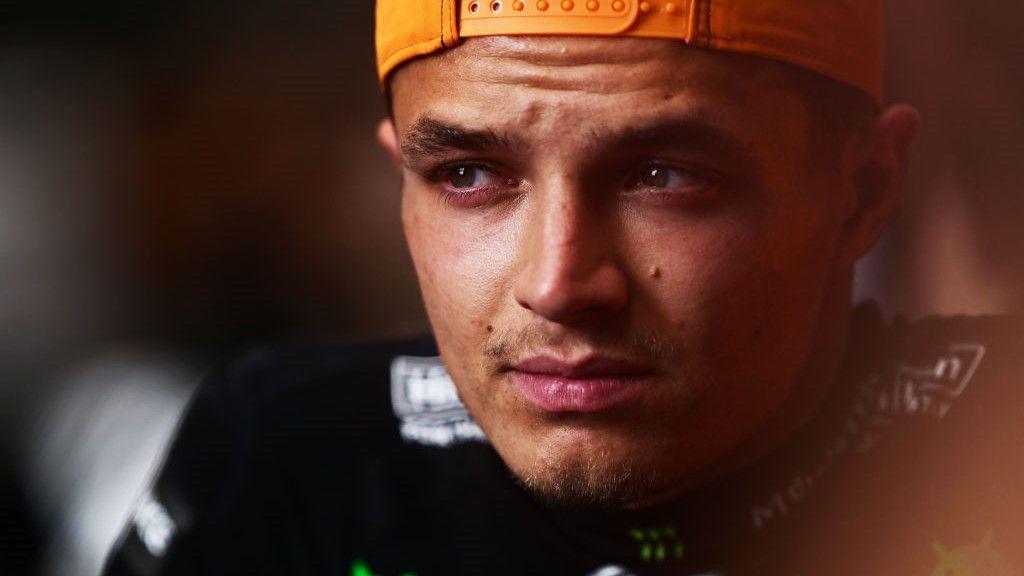Why did Hamilton struggle when Russell was competitive?

- Published
Max Verstappen climbed up from 17th to claim a stunning victory at a heavily rain-affected Sao Paulo Grand Prix, as he took what seems to be a decisive grip on the drivers' championship.
Alpine duo Esteban Ocon and Pierre Galsy joined him on the podium, while it was a difficult race for Verstappen's title rival Lando Norris, who could only finish sixth.
BBC F1 correspondent Andrew Benson answers your questions after the race in Sao Paulo.
Rain is the great equaliser of talent and cars; just how great among history is Max Verstappen in the rain? That was imperious, another class. – Nick
Any ranking of great wet-weather wins is inevitably subjective, but there are a handful held up as the very best, and it really does feel as if Verstappen in Sao Paulo on Sunday should be added to the list.
The candidates are well known to Formula 1 aficionados:
Jim Clark winning by almost five minutes, and lapping all but second-placed Jack Brabham, at Spa in Belgium in 1963
Jackie Stewart winning by four minutes in fog and rain at the Nurburgring in 1968
Ayrton Senna’s stunning win at the 1993 European Grand Prix at Donington Park, lapping all but second-placed Damon Hill after doing five pit stops in the changeable conditions, and that brilliant first lap, in which he passed four cars to take the lead
Michael Schumacher in a league of his own in Spain in 1996
Lewis Hamilton winning by more than a minute at Silverstone in 2008
You can add a few more, too, including Jenson Button's dramatic last-to-first win in Canada in 2011, and Gilles Villeneuve's annihilation of the field at Watkins Glen in 1979, for example.
All these races share characteristics - challenging conditions, often awful visibility, one driver apparently on a separate level from the rest of the field.
Those all apply to Verstappen in Brazil on Sunday.
His first lap was stunning - rising from 17th on the grid (although 15th car, as a result of Alex Albon and Lance Stroll not starting) to 11th. Then he was up to sixth by lap 11.
OK, Verstappen did not scythe through the group involving Yuki Tsunoda’s RB, Esteban Ocon’s Alpine and Ferrari’s Charles Leclerc as quickly as he might have been expected to do.
Yes, the win turned on a gamble on a red flag, which took George Russell and Lando Norris out of the picture - much to the annoyance of Russell, who disagreed with Mercedes’ decision to pit him for fresh tyres under the virtual safety car.
And in clear air, Verstappen did not have the huge advantage that Schumacher and Hamilton showed in Barcelona and Silverstone, where both were as much as five seconds a lap faster than anyone else.
But his overtaking moves were clean and clinical, and the one to take the lead from Esteban Ocon’s Alpine was a beauty - sending it on the brakes from at least two car lengths back.
Once into the lead, Verstappen was a lot faster than anyone else. It was different class.
And his win had something none of these other classics had - winning from so far back. That in itself is worthy of particular note.
So, yes, there are plenty of reasons to rank it right up there with the very best, and the same goes for Verstappen himself.
It’s far from the first time he has excelled in the wet - he always has. Think of his brilliant comeback to third in Brazil in 2016, for example.
- Published4 November 2024
Max Verstappen's drive in the wet was superb, but Lewis Hamilton is renowned for his wet driving. Why was he not competitive when George Russell was? – Howard
Hamilton had a very difficult weekend in Brazil, and it follows closely on from another equally difficult one in Austin two weeks before.
Any driver, no matter how great, needs to feel confidence in their car to perform at their best, and the Mercedes is simply not giving Hamilton the messages he needs. In Brazil, he could not build any confidence in the rear of the car.
This is what he said after the race on Sunday: "The race was crap but the driving Senna’s car (a demo run in the 1990 McLaren-Honda MP4-6) was the best thing ever. I’m still happy and grateful I had that experience here in Interlagos.
"An amazing reception from the fans. They turned up at 3am, I think, this morning. Let’s not talk about the car because the car is no good.
"It’s devastating to have these bad races in the second half of the season, but we are trying coming into the weekends, and it’s definitely not acceptable and not good enough.
"We and I have to take accountability. I am doing my best with what I’ve got. The car has been the worst this weekend. We will have to find out what it is. One of the cars is working a lot better, so there is obviously potential there."
How will he get through the remaining three races, he was asked?
"Put my focus on to something else," he replied. "I don’t care if I finish ahead or behind George. I just want to keep the car out of the wall and try to score points for the team. Give me a car that doesn’t bounce off the track and hopefully we can get a better result."
He added that the end of the season "can’t come soon enough".
There seem to be a combination of issues here.
In general, Hamilton has been struggling to get the best out of the ground-effect cars in qualifying since the current rules were introduced in 2022. This is because the cars don’t respond to being hustled aggressively, something a number of drivers have mentioned.
It remains an open question, though, as to why Hamilton - previously known for his adaptability - has not been able to adapt to the driving style required. And why he is sometimes struggling compared with Russell.
Brazil was an exception, but generally his race performances have been as strong as ever. He has taken two wins this year, and until Sunday was ahead of Russell in the championship, despite being well down on his team-mate in qualifying, both in their head-to-head and in average pace.
Clearly, something is not working between Hamilton and this Mercedes car, especially over one lap.

Driving Ayrton Senna's 1990 McLaren-Honda was the highlight of Lewis Hamilton's weekend in Interlagos
Should there be a change to the rules allowing tyres changes in red-flag conditions to remove the free pit stop advantage? – Nicola
This topic comes up from time to time in circumstances such as those in Brazil on Sunday. This rule quirk potentially decided the race, and certainly disadvantaged Lando Norris and George Russell to the benefit of Max Verstappen and the Alpine drivers, who eventually finished on the podium.
The other race that always springs to mind is Monaco in 2011, when the final stages were building into a gripping climax between Sebastian Vettel’s Red Bull, Fernando Alonso’s Ferrari and Jenson Button’s McLaren.
Vettel was on tyres that may or may not have made it to the end of the race - Alonso’s considerably fresher, and Button’s fresher still.
Could Vettel hold them off? The question became redundant when there was a multi-car crash at the Swimming Pool and the race was red-flagged.
Another example is Pierre Gasly’s win for Alpha Tauri at the 2020 Italian Grand Prix, when a pit stop just before a red flag led to the Frenchman being promoted to third, behind Lewis Hamilton, who had a penalty, and Lance Stroll, who still needed to stop. And that became a win.
After that Monaco race, I remember asking the late FIA F1 director Charlie Whiting why that rule was in place. He agreed it wasn’t very fair and should be looked at. But nothing happened when he was alive, and it still hasn’t since he died on the eve of the 2019 season.
It does seem anomalous, and it can be argued it is unfair. It can also be argued that in circumstances such as Brazil on Sunday it leads to teams and drivers taking unnecessary risks.
Red Bull and Alpine decided to leave Verstappen, Esteban Ocon and Pierre Gasly out on worn intermediate tyres exactly because they expected there to be a big crash and a red flag - and George Russell wanted to do the same.
This is despite Verstappen admitting it was “sketchy” and Russell saying the conditions were “undriveable”.
On the other side, it can be argued that the rules are what they are, and it adds the potential for upsets, and extra interest.
Lando Norris said: "It’s a silly rule that no one agrees with but you will always agree when it benefits you. Every driver has said that they don't agree with it and wanted it changed, but it's a rule, you win some, you lose some. It has benefited them, so well done to them."
Perhaps now it will be changed. But I wouldn't bet on it.
The safety car was deployed because it was 'too wet' to race, but most drivers were still on intermediate tyres. What is the point of the full wets? – Martin
It’s a question many drivers also ask. And even Pirelli admits that its full wet tyre - known as the ‘extreme’ - needs to be improved.
Sebastian Vettel used to call it the "safety-car tyre". That’s because it was effectively only used when races were controlled under caution, and its use was mandated.
The issue is that while the extreme wet clears more water than the intermediate, it lacks grip. So the drivers want to get on to the intermediate as soon as possible because it's faster unless the conditions are really torrential - conditions in which F1 cars generally don’t run because of the danger of such restricted visibility.
The 'inter' has good grip, and a wide working window, effective in conditions that are very wet right down to almost dry.
This situation will continue until Pirelli can improve the full wet tyre. Boss Mario Isola says they need more testing to do that.
What can and can't you change during parc ferme and does this change during the wet or after crashes? – Joe
‘Parc ferme’ is a rule that effectively specifies a time beyond which the set-up and specification of the car are fixed. The idea behind it is to reduce costs.
On any grand prix weekend, cars are in parc ferme from the start of qualifying to the end of the race. On a sprint weekend, there is a second closed window, from the start of sprint qualifying to the end of the sprint, after which the set-up can be changed before qualifying.
The details of parc ferme can be found in article 40 of the sporting regulations on the FIA website, external.
But in simple terms, teams can change only the angle of the front wing once the car is in parc ferme, in addition to repairing any damage, as long as the FIA approves it.
If the FIA declares a change of climatic conditions, further changes can be made to make the car more suitable for wet weather.
Related topics
- Published3 November 2024

- Attribution